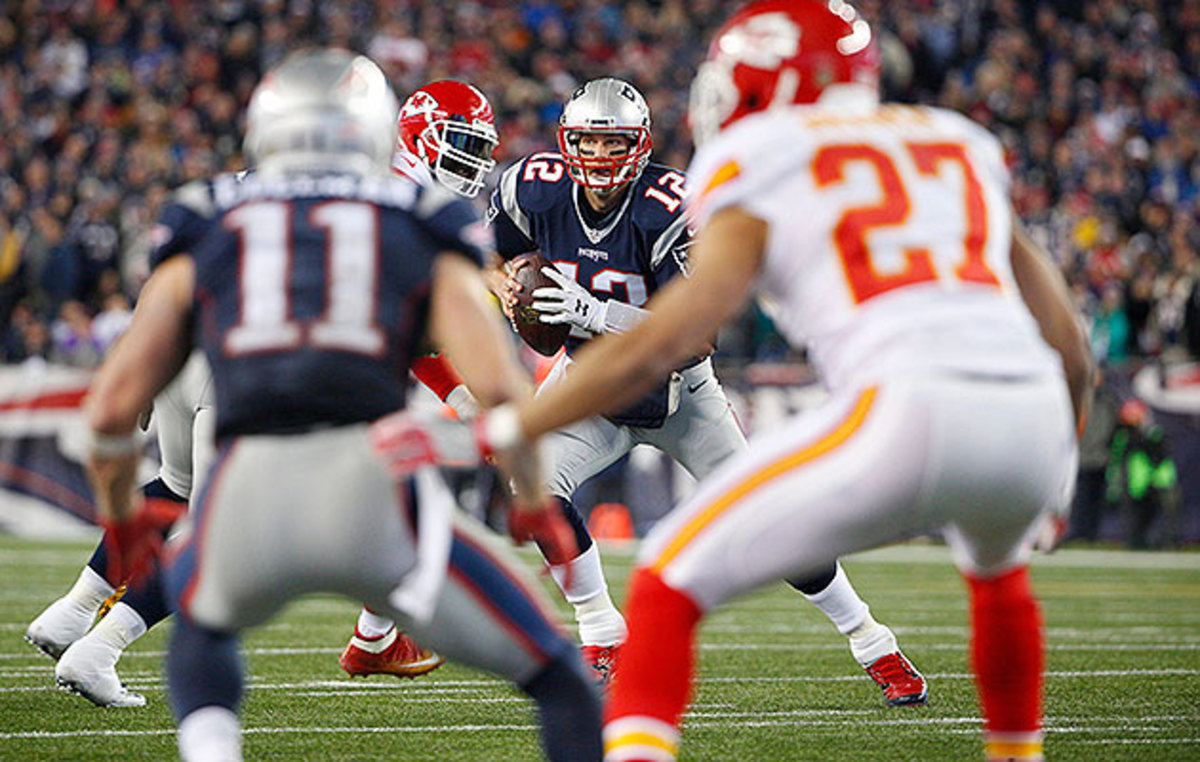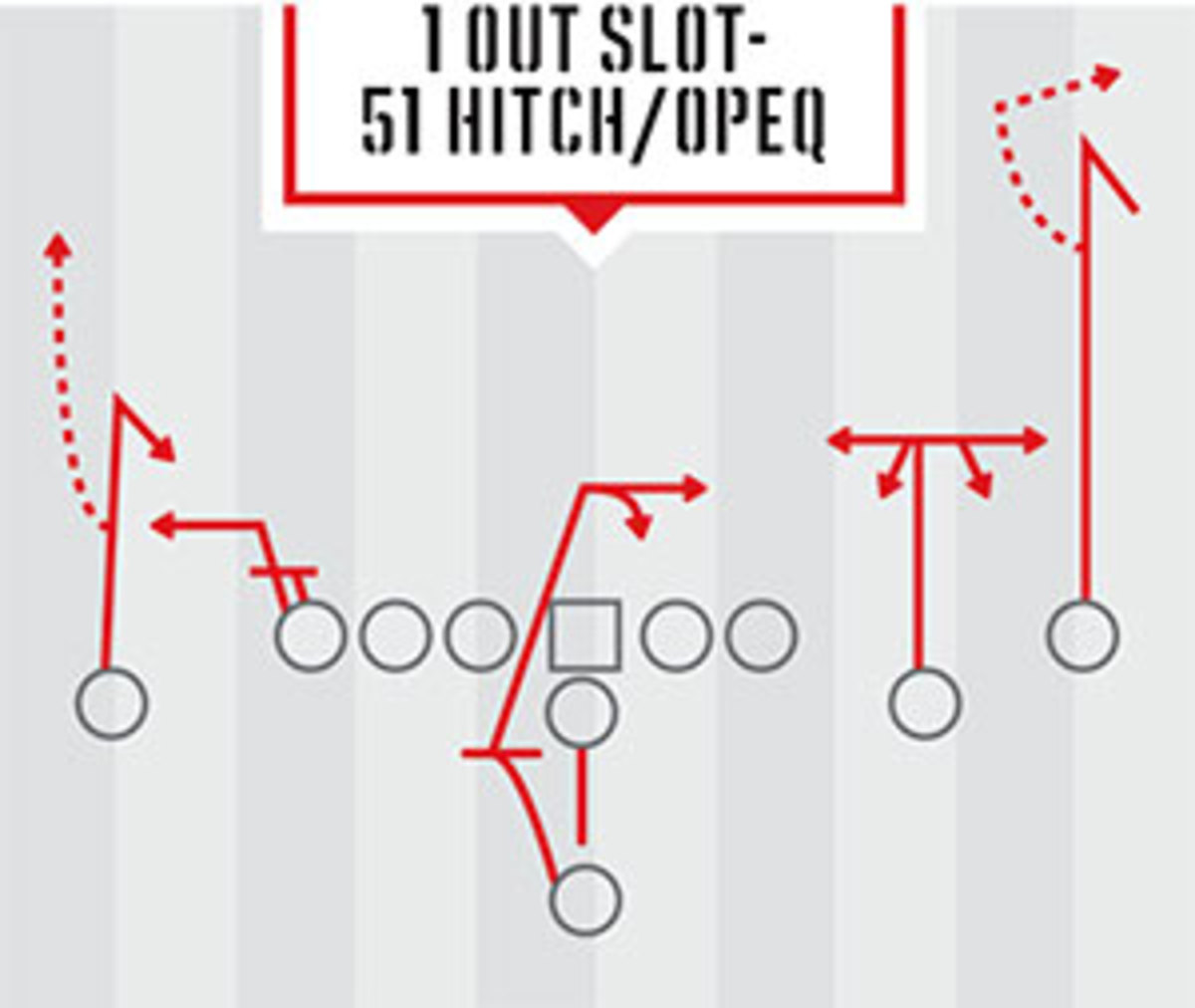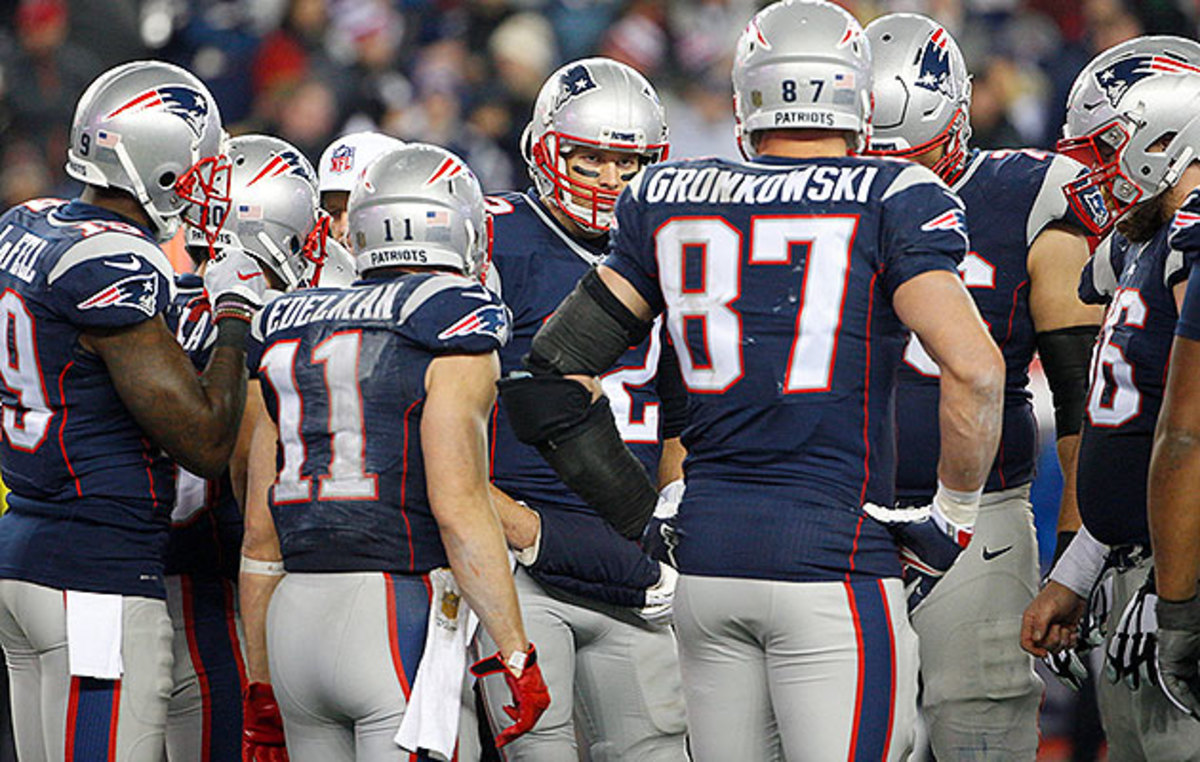Ch-Ch-Ch-Ch-Changes: Brady and Patriots’ offense are built to adapt

This story appears in the Jan. 25, 2016, issue of Sports Illustrated. Subscribe to the magazine here.
Exotic birds in cages screech every few seconds in the background, their shrill cries echoing off the walls, the tile floor and the sliding glass doors inside this South Florida echo chamber. Outside, beyond the back patio and the pool, is a stable of six horses and a large riding area—typical stuff for this equestrian community near West Palm Beach. Maybe it’s this bewildering backdrop, or maybe it’s the fact that it’s four days before Christmas and it's 85˚ and humid. Something is making this a maddening experience, trying to get on the same page with Charlie Weis about the Patriots’ offense.
“No, it’s not a sight adjustment, it’s just what he does on the route,” says the 59-year-old Weis, who 16 years ago, in his first season as the team’s offensive coordinator, installed the offense that the Patriots still use (with some modifications) today. Now retired from the game, he is being extremely patient with his guest. But he’s also a little frustrated.
Squawk!
The dish-washer in Ann Arbor who factors into Brady's weekly routine
Choice routes. Option routes. Route conversions. Sight adjustments. And the rules aren't the same for a drop-back pass versus play-action. In the game film playing on a laptop, Tom Brady yells at his receivers and....
Squawk!
Sitting at Weis’s dining table, one begins to understand what makes the Patriots’ offense so difficult for even New England’s own receivers to comprehend—and so tough for opponents to defend, no matter the caliber of pass catcher number 12 is throwing to. Last Saturday it was the Chiefs who left Gillette Stadium shaking their heads, like so many other Super Bowl hopefuls before them, after Brady and this offense got the better of them, 27–20, to advance to the AFC Championship Game. Again.
“Not every offense does this, but this is our offense,” says Weis, who, having left New England on good terms in 2005 to become the coach at Notre Dame, is basically a lifetime member of the Patriots’ familia. “I don’t know why [other teams] don’t do it. I don’t know why you would want to do it any other way.”
Squawk!
On the occasion of Brady’s record 22nd playoff win, let’s set the story straight on a bit of mythology surrounding the quarterback’s rise: Pats coach Bill Belichick was not looking for a reason to bench starter Drew Bledsoe back in 2001 when Jets linebacker Mo Lewis hit the QB so hard that he put Bledsoe in the hospital. Actually, another New England passer, Damon Huard, very well could have been the man to fill Bledsoe's shoes—the competition was that close.
“Oh no, no, no, no,” Weis says of that popular tale, the one that has Brady, a Belichick draft pick, waiting in the wings behind owner Robert Kraft’s preferred leader, Bledsoe. “[Brady] wasn’t better than Bledsoe. In fact he wasn’t much better than [Huard]. Bledsoe was clearly the starter. The No. 2 spot, that’s where the competition was. We really could have flipped a coin to pick the second guy. We ended up picking Tommy—but it was really close.”
Blanket Coverage: Phillips needs to shake up schemes for AFC title game
But this isn’t a story about Brady's ascension, which has him headed to his 10th conference championship game. This is about a perfect marriage between a QB and an offense—an offense that, if executed correctly, is almost unstoppable. Take any of the herky-jerky option routes that ace slotman Julian Edelman converted into 10 catches for 100 yards against Kansas City. “I’ve played in a lot of different offenses,” says QB Brian Hoyer, who after starting his career in New England landed this season with Houston. “[The Patriots’] system is a hybrid of all of them. It’s very intricate, but if you have guys who can do it well, it’s the best. And if, in that offense, you have the best QB ever to play the game? Well.... ”
At the heart of that system is the responsibility heaped upon the QB’s shoulders. That starts with the “alert” system, in which most play calls are essentially two-in-one. There’s the original call, plus an alternate that gets put into motion if the D aligns a certain way. Brady yells, “Alert!” to make the switch. (The Patriots didn’t need an alert call against the Chiefs until Steven Jackson’s two-yard run with 11:47 left in the fourth quarter—that’s how attuned coordinator Josh McDaniels was to his play-calls.) In New England there are also “look” passes: run plays that are converted to quick dump-offs should Brady see a corner playing well off a receiver. (Most offenses now include some form of this.)
But what truly separates the Patriots’ system is the extensive combination of receiver route adjustments, based on the defense or a defender’s positioning, that all pass catchers—even running backs—have to know. Most offenses include at least a sprinkling of option routes designed, essentially, to use a defense against itself. But New England’s offense is built on them.
“At times there are four decisions that a receiver needs to make after the snap,” Chad O’Shea, New England’s receivers coach since 2009, explained in the lead-up to Super Bowl XLVI, a loss to the Giants. “That’s one advantage of our offense: We give players the flexibility to take what the defense gives.”
That complexity can prove maddening for rookies and veterans imported from other teams who are trying to learn the system. Consider: Since taking Deion Branch (round 2) and David Givens (round 7) in 2002, the Patriots’ track record at drafting receivers has been abysmal. Since then they’ve selected eight wideouts in the fifth round or higher, 11 overall. And from Bethel Johnson (round 2, ’03) to Aaron Dobson (round 2, ’13), almost all failed. The only success story: a seventh-rounder in ’09 named Julian Edelman. “You know why he made it, right?” Weis asks of the player who after missing seven games with a broken foot revived a stagnant offense last Saturday. “Because he was a college quarterback. He thinks like a quarterback. He’s really sharp.” (New England’s success rate in free agency might be even worse: David Terrell, ’05; Joey Galloway, ’09; Chad Ochocinco, ’11; Reggie Wayne, ’15....)
So, what kind of receiver does work in this offense? What does it take? In short, smarts—and practice. “I use the example of Deion Branch and the hours of work he put in with [Brady],” says Texans coach Bill O'Brien, who worked on the Patriots’ O from 2007 through ’11 and brought the system to Houston in ’14. “I’d say the same thing about [Rob] Gronkowski. During Gronk’s rookie year, [Brady] would keep that kid after practice for hours. We’d say, ‘Tom, you’re going to kill this guy.’ ”
Brady has admitted he’s not the easiest QB to play with. Against the Chiefs he made clear his displeasures with Edelman and shot a frustrated glance at Brandon LaFell after the receiver shortened a route. “If you haven’t weeded out the guys that you don’t count on anymore, those guys, they’re not playing,” Brady told reporters last week. “The guys that you count on, those are the guys that you’re kind of in a foxhole with.... You’ve got to know who to count on.”

What, exactly, is so complicated? Why is New England the place that rookies and once productive receivers—with rare exception—go to see their careers extinguished?
Tom Brady vs. Peyton Manning: The definitive all-time box score
On most plays, every eligible receiver is expected to be able to adjust his route—and this after Brady may have alerted to an alternate play—depending on the defense. Here’s a rundown of the different types of route modifications New England runs:
ROUTE CONVERSION: If a play is designed for, say, a comeback route (or a hitch) and the defender is playing in press man instead of the anticipated zone coverage, a receiver might convert his route to a fade down the sideline.
SIGHT ADJUSTMENT: If a receiver recognizes that his defender—usually a safety—is coming on a blitz, he’ll adjust his route. (Simply put: Conversions are based on coverage type, adjustments react to blitzing DBs.) A vertical route, for example, might adjust to a slant, getting the receiver open more quickly in the void the safety just created. This is different from a hot route, which most teams use to thwart front-seven blitzes and which are usually executed by tight ends or backs.
CHOICE ROUTE: Referred to by some teams as a “two-way go,” this usually occurs with a tight end or an outside receiver. In essence, if the defender plays you inside, you break outside. If there are two split safeties in the middle of the field (termed “middle of field open”), a receiver may split them; against one safety (“middle closed”), the receiver would stay in the seam.
OPTION ROUTE: This almost always involves the slot receiver playing off the defense. Against a zone, for example, he’ll sit down for a short pass. Against man coverage, he could break right, left or go deep depending on the positioning and the skills of the man in coverage. On the Patriots’ first third-down attempt against the Chiefs, Edelman took the option to turn for a seven-yard pass and then spun for another four. To see what these concepts might look like in execution, let's examine a play design from an old Weis playbook:

which is almost certainly still in the Pats’ arsenal. It starts in a three-receiver set, one to the left and two to the right; the quarterback under center, with a single back behind him; and the tight end on the left side of the line. The left-aligned receiver runs a six-yard hitch, but that route converts to a fade if he sees press coverage or if the safeties roll coverage down to his side. The tight end blocks but then releases into the left flat if the play breaks down and extends. The running back picks up the middle linebacker if he blitzes; if he doesn’t, the back runs a middle check-down and then can release in the opposite direction of the tight end. On the right, the slot receiver runs a six-yard option route that can be a comeback, curl, dig or out, depending on the coverage. The outside receiver to the right runs a 14-yard comeback that converts to a post-corner if the safeties roll coverage.
Got it? Now imagine that you’re a wideout, and the coach tells you that instead of being the Z receiver, as you were the previous two weeks, you’re going to be the X on this play this week. “It’s very hard [to learn] because we’re constantly putting people in different spots, so you have to know multiple positions,” says Hoyer of the Texans’ version of the system. “You have to make adjustments on the fly relating to coverage. It can be a lot, especially if you’ve played five years in a system where your route is predetermined.”
The magic of the system boils down to receivers interpreting a defense the exact same way—and as quickly—as the quarterback, putting themselves exactly where the QB expects. Good luck with that, especially with Brady at the helm.
The ties that bind the four head coaches left in the NFL playoffs
“I don’t know if I’ve ever met anyone who reads coverages as quickly and correctly,” says Weis, who still texts with Brady weekly. “[When I was there] you could count on one hand the times he saw something incorrectly. He’d come over to the sideline, and I’d say, ‘They were in quarters coverage.’ And he’d say, ‘But they were moving to [cover] five.’ You’d go back the next day, watch the film, and you could see what he saw.”
In Brady’s third game as a starter, at home against the Chargers in 2001, New England game-planned for an audible against a blitz that San Diego liked to use: two rushers coming from the weak side. The Patriots thought they had a great answer, but the Chargers still hadn’t called the blitz as the game went into overtime. Then, on New England’s first play of the extra period, San Diego dialed up the blitz. “Oh, s---, here it is,” Weis remembers saying to himself on the sideline. “There isn’t a chance in hell the kid is going to see this.”
But Brady spotted it: He checked off and threw deep to David Patten, drawing a 37-yard pass-interference penalty that put the Pats on the Chargers’ 40-yard line and set up the winning field goal. In the locker room after the game, coaches marveled at Brady’s quick thinking. Weis passed on his feelings about the young QB to his wife later that night.
“He said, ‘I think this kid is going to be one of the greatest ever,’ ” recalls Maura Weis, just in from practicing her dressage in the backyard. “I asked ‘Like Joe Montana?’ ” referring to her husband's former Notre Dame classmate.
“Maybe better.”

Ultimate 2016 NFL Championship Weekend Power Rankings
Making things even harder for modern-day Patriots is the sheer volume of material that has been layered on since those nascent days under Weis (who, to be fair, didn't exactly invent the whole scheme—he built on a system that New England assistants Ron Erhardt and Ray Perkins created in the 1970s and then brought to the Giants, where Weis learned it in the early '90s). When Weis left for Notre Dame, he had in his playbook 50 individual routes, 29 two-man routes, 11 three-man combinations and four miscellaneous routes. Later, McDaniels took over as offensive coordinator and put his spin on the playbook, as did O’Brien after McDaniels left to coach the Broncos in ’09. (McDaniels returned to run New England’s offense in ’12.) When O'Brien arrived in Houston last year, his first Texans playbook included 109 individual routes, 110 two-man combinations, 67 three-man concepts and 44 miscellaneous routes. “Charlie installed [this offense],” says Hoyer, but “from seeing old call sheets, watching old film, it was very toned down. Now it’s nowhere near where it was in 2000, with the alerts and all that stuff. Brady ... is constantly adding stuff.”
When Brady is surrounded by talented players who know the system and can execute it—like the group the Patriots had during the bulk of their 10–0 start, with Gronkowski, Edelman, receiver Danny Amendola and running back Dion Lewis mostly healthy—this offense can make sweet, unstoppable music. And when Brady doesn’t have that luxury? Whoever those players are, they won’t be staying around for long. “There were a couple guys in our past, he wouldn’t throw the ball to them,” says Weis. “You’d get pissed and say, ‘Why didn’t you throw to him?’ He'd answer, ‘I didn’t trust him.’ Which is not really a bad answer. It’s not the right answer, but it's not a bad answer.”
